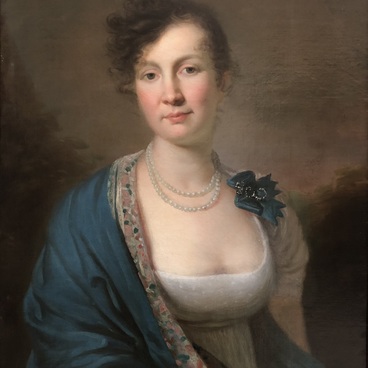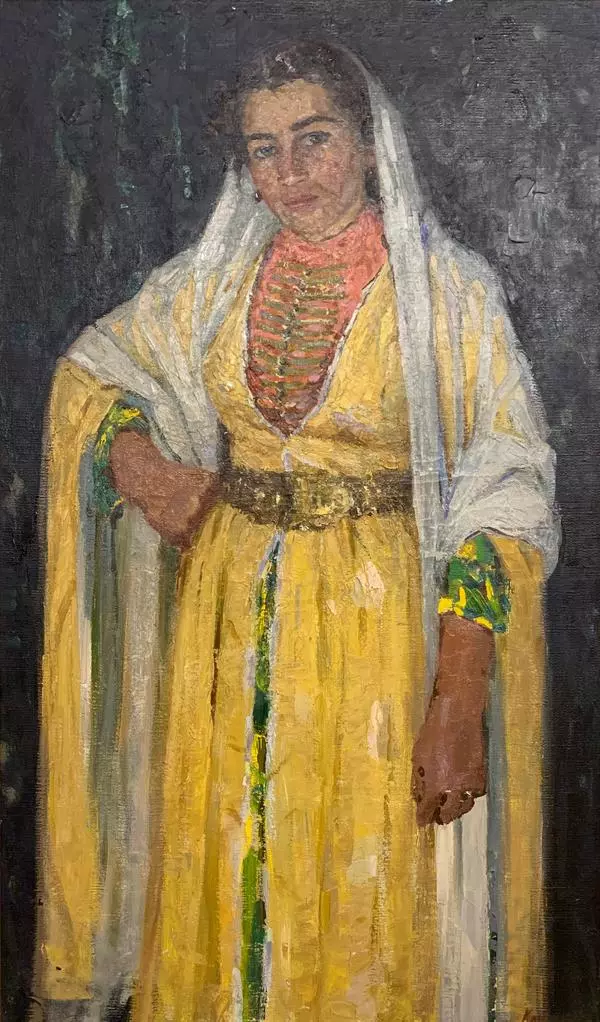Oleg Klyukin painted the Sunzha River Embankment in 1954. He worked in the watercolor-on-cardboard technique. The artist depicted a view on the pre-war Grozny. On the right side, he captured Dzerzhinsky Square with a large fountain. On the left, one can see a pedestrian bridge across the Sunzha River. In the 1970s, two famous hotels stood right behind the park square: the Seagull and the Ocean. The park used to be a popular holiday destination of the townsfolk. When the water level in the river was low, people often came down the stairs to the Sunzha bank. At present, this area sports a modern complex of high-rise buildings called Grozny City, which includes seven skyscrapers.
Oleg Klyukin graduated from an art school in 1951. A year later he got assigned to Chechnya. He lived in the village of Chernorechye and worked in Grozny. The artist’s studio was located near Minutka Square, where he worked on a diorama that was commissioned for the Grozny Museum of Local Lore. He spent 13 years in Chechnya, and in 1957, he went to Moscow to attend the 6th World Festival of Youth and Students as a member of delegation from the Chechen-Ingush Autonomous Soviet Socialist Republic.
A lot of his works were created between 1952 and 1965. Oleg Klyukin painted landscapes, portraits, still-life pieces. His works featured small mountain villages and huge glaciers, numerous mountain and river views, as well as urban streets. A great number of his paintings were created in Chechen mountainous regions, Ingush villages, on the shores of the Caspian Sea, and in the city of Grozny. His paintings stand out with rich and vivid colours, as well as original compositional solutions.
In 1965, the artist moved from Grozny to the town of Noginsk in the Moscow region. He spent his last years across the Volga River, in the vicinity of the ancient Russian town of Gorodets, where he lived and worked. The National Museum of the Chechen Republic holds a collection of the artist’s paintings. The Elena and Gennady Timchenko Moscow Charitable Foundation has donated to the museum 49 works, thus bringing to Grozny the artist’s paintings that he created in these parts. Oleg Klyukin’s works constitute an integral part of the history of artistic life in the region.
Oleg Klyukin graduated from an art school in 1951. A year later he got assigned to Chechnya. He lived in the village of Chernorechye and worked in Grozny. The artist’s studio was located near Minutka Square, where he worked on a diorama that was commissioned for the Grozny Museum of Local Lore. He spent 13 years in Chechnya, and in 1957, he went to Moscow to attend the 6th World Festival of Youth and Students as a member of delegation from the Chechen-Ingush Autonomous Soviet Socialist Republic.
A lot of his works were created between 1952 and 1965. Oleg Klyukin painted landscapes, portraits, still-life pieces. His works featured small mountain villages and huge glaciers, numerous mountain and river views, as well as urban streets. A great number of his paintings were created in Chechen mountainous regions, Ingush villages, on the shores of the Caspian Sea, and in the city of Grozny. His paintings stand out with rich and vivid colours, as well as original compositional solutions.
In 1965, the artist moved from Grozny to the town of Noginsk in the Moscow region. He spent his last years across the Volga River, in the vicinity of the ancient Russian town of Gorodets, where he lived and worked. The National Museum of the Chechen Republic holds a collection of the artist’s paintings. The Elena and Gennady Timchenko Moscow Charitable Foundation has donated to the museum 49 works, thus bringing to Grozny the artist’s paintings that he created in these parts. Oleg Klyukin’s works constitute an integral part of the history of artistic life in the region.



